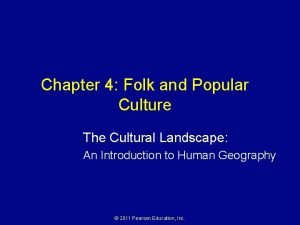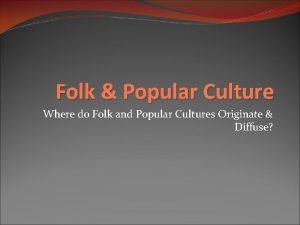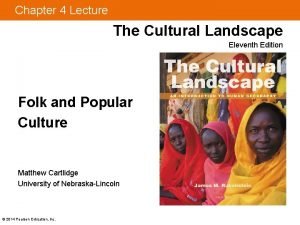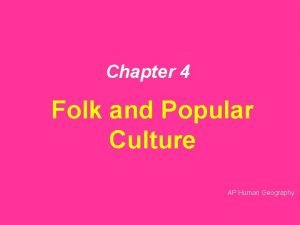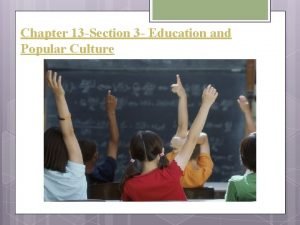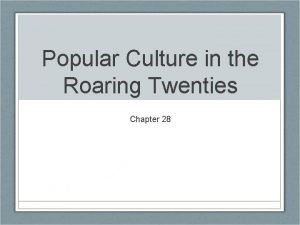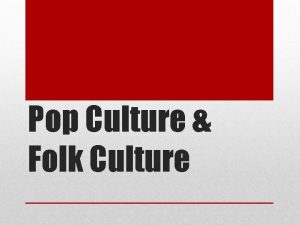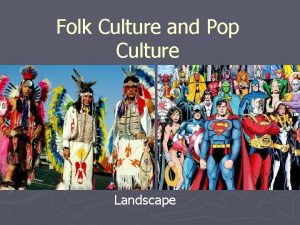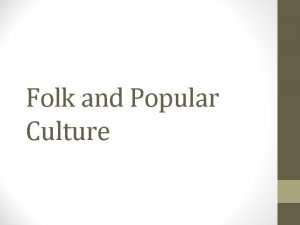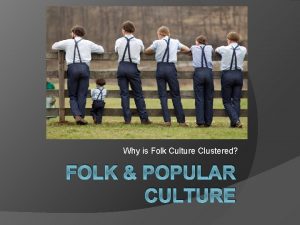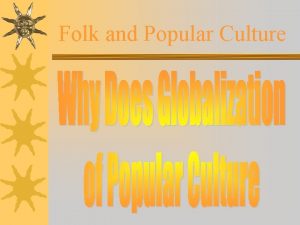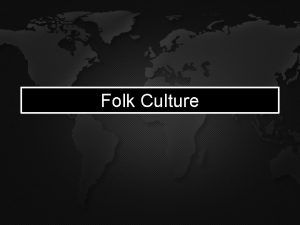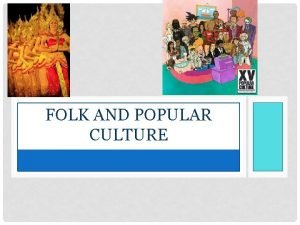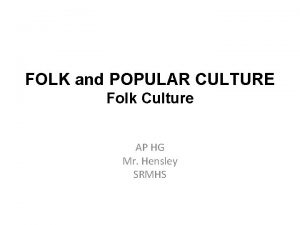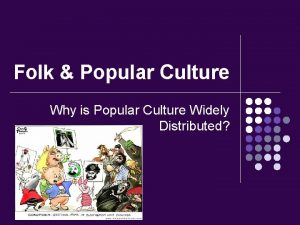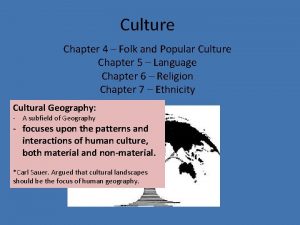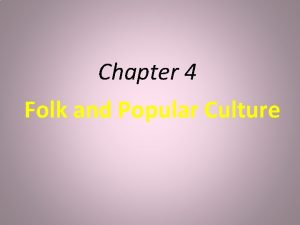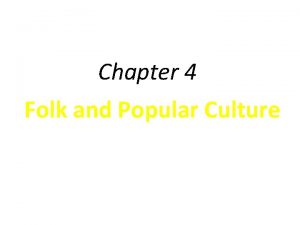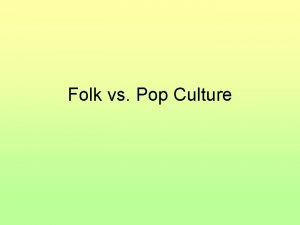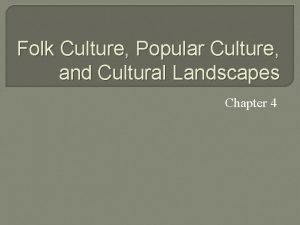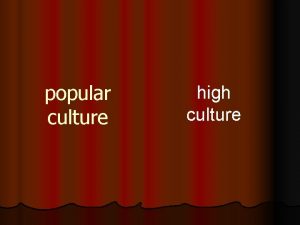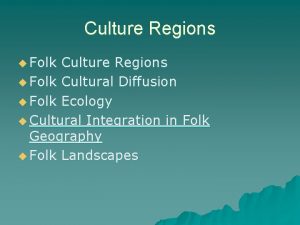Chapter 4 Folk and Popular Culture Read pg

























- Slides: 25


Chapter 4 Folk and Popular Culture

§ Read pg. 108 in book

Culture and Customs § People living in other locations often have extremely different social customs. § Geographers ask why such differences exist and how social customs are related to the cultural landscape.

Folk and Popular Culture § The Key Issues are: 1. Where do folk and popular cultures originate and diffuse? 2. Why is folk culture clustered? 3. Why is popular culture widely distributed? 4. Why does globalization of popular culture cause problems?

Material Culture · Material artifacts of culture are the visible objects that a group possesses and leaves behind for the future. § Here we look at two facets of material culture. 1) Survival activities. 2) Leisure activities § The arts § Recreation.

Material Culture Defined § Culture can be distinguished from habit and custom. § A habit is a repetitive act that a particular individual performs. § A custom is a repetitive act of a group. § A collection of social customs produces a group’s material culture.

Folk vs. Popular Culture § Folk culture is traditionally practiced primarily by small, homogeneous groups living in isolated rural areas. § Popular culture is found in large, heterogeneous societies.

Folk vs. Popular Culture Continued § Landscapes dominated by a collection of folk customs change relatively little over time. § In contrast, popular culture is based on rapid simultaneous global connections. § Thus, folk culture is more likely to vary from place to place at a given time, whereas popular culture is more likely to vary from time to time at a given place.

Effects of Popular Culture § In Earth’s globalization, § § popular culture is becoming more dominant, threatening the survival of unique folk cultures. The disappearance of local folk customs reduces local diversity in the world and the intellectual stimulation that arises from differences in background. The dominance of popular culture can also threaten the quality of the environment.

Issue 1: Origins and Diffusion of Folk and Popular Cultures § Origin of folk and popular cultures § Origin of folk music § Origin of popular music § Diffusion of folk and popular cultures § The Amish: Relocation diffusion of folk culture § Sports: Hierarchical diffusion of popular culture

Origin of Folk and Popular Cultures § A social custom originates § § at a hearth, a center of innovation. Folk customs often have anonymous hearths. They may also have multiple hearths. Popular culture is most often a product of the economically more developed countries. Industrial technology permits the uniform reproduction of objects in large quantities.

Folk Music § Music exemplifies the differences in the origins of folk and popular culture. § Folk songs tell a story or convey information about daily activities such as farming, life-cycle events (birth, death, and marriage), or mysterious events such as storms and earthquakes.

Origin of Country Music Fig. 4 -1: U. S. country music has four main hearths, or regions of origin: southern Appalachia, central Tennessee and Kentucky, the Ozark-Ouachita uplands, and north-central Texas.

Origin of Popular Music § In contrast to folk music, popular music is written by specific individuals for the purpose of being sold to a large number of people.

Diffusion of American Music § The diffusion of American popular music worldwide began in earnest during World War II, when the Armed Forces Radio Network broadcast music to American soldiers. § English became the international language for popular music.

Hip Hop § Hip hop is a more recent form of popular music that also originated in New York. § Lyrics make local references and represent a distinctive hometown scene. § At the same time, hip hop has diffused rapidly around the world through instruments of globalization.

A Mental Map of Hip Hop Fig. 4 -3: This mental map places major hip hop performers near other similar performers and in the portion of the country where they performed.

Diffusion of Folk and Popular Cultures § The broadcasting of American popular music on Armed Forces radio illustrates the difference in diffusion of folk and popular cultures. § The spread of popular culture typically follows the process of hierarchical diffusion from hearths or nodes of innovation. § In contrast, folk culture is transmitted primarily through migration, relocation diffusion.

The Amish: Relocation Diffusion of Folk Culture § Amish customs illustrate how § § relocation diffusion distributes folk culture. Amish folk culture remains visible on the landscape in at least 17 states. In Europe the Amish did not develop distinctive language, clothing, or farming practices and gradually merged with various Mennonite church groups. Several hundred Amish families migrated to North America in two waves. Living in rural and frontier settlements relatively isolated from other groups, Amish communities retained their traditional customs, even as other European immigrants to the United States adopted new ones.

Amish Settlements in the U. S. Fig. 4 -4: Amish settlements are distributed through the northeast U. S.

Sports: Hierarchical Diffusion of Popular Culture § In contrast with the diffusion of folk customs, organized sports provide examples of how popular culture is diffused. § Many sports originated as isolated folk customs and were diffused like other folk culture, through the migration of individuals. § The contemporary diffusion of organized sports, however, displays the characteristics of popular culture.

Folk Culture Origin of Soccer § Early soccer games resembled mob § § scenes. In the twelfth century the rules became standardized. Because soccer disrupted village life, King Henry II banned the game from England in the late twelfth century. It was not legalized again until 1603 by King James I. At this point, soccer was an English folk custom rather than a global popular custom.

Globalization of Soccer § The transformation of soccer from § § § an English folk custom to global popular culture began in the 1800’s. Sport became a subject that was taught in school. Increasing leisure time permitted people not only to view sporting events but to participate in them. With higher incomes, spectators paid to see first-class events.

Soccer’s Globalization § Soccer was first played in § § § continental Europe in the late 1870 s by Dutch students who had been in Britain. British citizens further diffused the game throughout the worldwide British Empire. In the twentieth century, soccer, like other sports, was further diffused by new communication systems, especially radio and television. Although soccer was also exported to the United States, it never gained the popularity it won in Europe and Latin America
 Folk culture and popular culture venn diagram
Folk culture and popular culture venn diagram Folk cultures are spread primarily by
Folk cultures are spread primarily by Homework due today
Homework due today Chapter 4 folk and popular culture
Chapter 4 folk and popular culture Chapter 4 folk and popular culture
Chapter 4 folk and popular culture Folk and popular culture
Folk and popular culture How do the origins of folk and popular culture differ
How do the origins of folk and popular culture differ How does folk culture diffuse
How does folk culture diffuse Why is access to folk and popular culture unequal
Why is access to folk and popular culture unequal Habit ap human geography
Habit ap human geography What is folk local cultur
What is folk local cultur Chapter 13 section 3 education and popular culture
Chapter 13 section 3 education and popular culture Chapter 13 section 3 education and popular culture
Chapter 13 section 3 education and popular culture Chapter 28 popular culture in the roaring twenties
Chapter 28 popular culture in the roaring twenties Chapter 19 section 1 postwar america
Chapter 19 section 1 postwar america Whats the definition of culture
Whats the definition of culture Media pop culture
Media pop culture Pop culture of the 1950s
Pop culture of the 1950s Threats to folk culture
Threats to folk culture Where does the 100 take place
Where does the 100 take place Folk culture sports
Folk culture sports Surviving folk sports
Surviving folk sports Folk food definition
Folk food definition Why is folk culture clustered?
Why is folk culture clustered? Why do ldcs fear the loss of folk culture
Why do ldcs fear the loss of folk culture Amish folk culture
Amish folk culture



